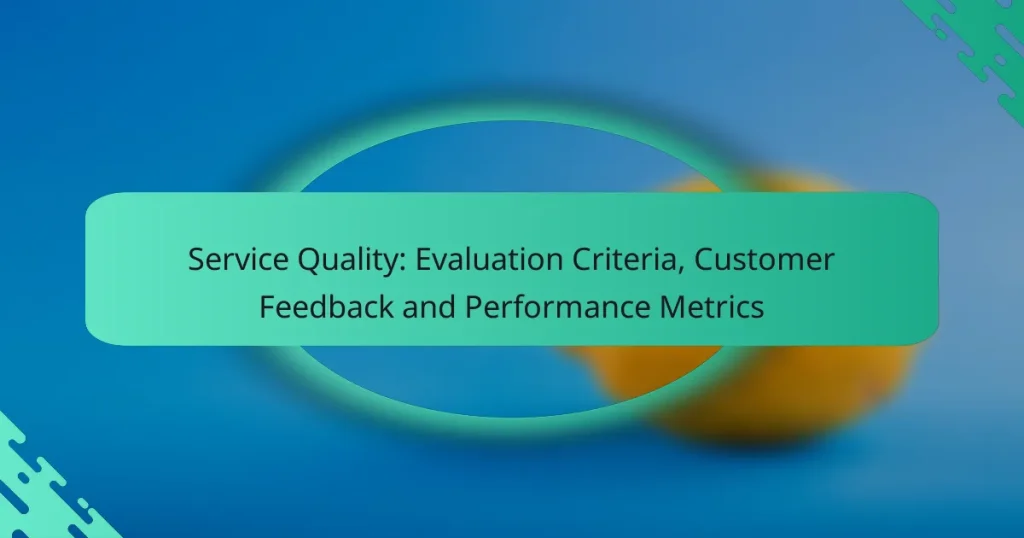Service quality evaluation in local businesses is crucial for enhancing customer experience and satisfaction. By gathering customer feedback and measuring performance metrics, organizations can identify strengths and areas for improvement. Key performance indicators such as response times and customer retention provide valuable insights into service effectiveness, guiding businesses in their efforts to meet customer needs more efficiently.

How to evaluate service quality in local businesses?
Evaluating service quality in local businesses involves assessing various factors that contribute to customer experience. Key methods include gathering customer feedback, measuring performance metrics, and establishing clear service standards.
Customer satisfaction surveys
Customer satisfaction surveys are a direct way to gauge how well a business meets its customers’ needs. These surveys can be conducted online or in-person and typically include questions about service quality, product satisfaction, and overall experience.
To maximize effectiveness, keep surveys concise and focused. Aim for a response rate of at least 20-30% to ensure reliable data. Consider offering small incentives, like discounts, to encourage participation.
Net Promoter Score (NPS)
The Net Promoter Score (NPS) measures customer loyalty by asking how likely customers are to recommend a business to others. Responses are categorized into promoters, passives, and detractors, providing a clear picture of customer sentiment.
A good NPS score typically ranges from 0 to 100, with scores above 50 considered excellent. Regularly tracking NPS can help identify trends and areas for improvement in service quality.
Service level agreements (SLAs)
Service level agreements (SLAs) are formal contracts that outline expected service standards between a business and its customers. These agreements specify metrics such as response times, service availability, and resolution times.
Establishing SLAs helps set clear expectations and provides a framework for measuring service quality. Ensure SLAs are realistic and regularly reviewed to adapt to changing customer needs and business capabilities.
Performance benchmarking
Performance benchmarking involves comparing a business’s service quality metrics against industry standards or competitors. This process helps identify strengths and weaknesses in service delivery.
Use key performance indicators (KPIs) such as average response time, customer retention rates, and complaint resolution times for effective benchmarking. Aim to analyze these metrics quarterly to stay competitive.
Employee feedback
Employee feedback is crucial for understanding service quality from the staff’s perspective. Engaging employees in discussions about service processes can uncover insights that improve customer interactions.
Conduct regular feedback sessions or anonymous surveys to gather input. Encouraging open communication fosters a culture of continuous improvement, ultimately enhancing service quality for customers.

What metrics are essential for measuring service performance?
Essential metrics for measuring service performance include response times, resolution rates, customer retention, and service availability. These indicators help organizations assess their efficiency and effectiveness in meeting customer needs.
Response time metrics
Response time metrics gauge how quickly a service team addresses customer inquiries or issues. This can include initial response times, which typically range from a few seconds to several minutes, depending on the service channel.
To improve response times, businesses should implement automated systems for common queries and ensure adequate staffing during peak hours. Tracking these metrics regularly can highlight trends and areas needing improvement.
First contact resolution rate
The first contact resolution rate measures the percentage of customer issues resolved during the first interaction. A high rate, ideally above 70%, indicates effective service and reduces the need for follow-up communications.
To enhance this metric, provide comprehensive training for service representatives and empower them with the necessary tools and information. Regularly reviewing cases can help identify common issues and improve resolution strategies.
Customer retention rates
Customer retention rates reflect the percentage of customers who continue to use a service over a specific period. A retention rate above 80% is often considered strong, indicating customer satisfaction and loyalty.
To boost retention, focus on delivering consistent quality and engaging with customers through feedback channels. Implement loyalty programs or personalized communications to strengthen relationships and encourage repeat business.
Service uptime and availability
Service uptime and availability metrics indicate the percentage of time a service is operational and accessible to customers. A target of 99% uptime is common in many industries, ensuring minimal disruption to users.
To maintain high availability, invest in reliable infrastructure and conduct regular maintenance checks. Monitoring tools can help quickly identify and address outages, ensuring that service levels meet customer expectations.

How to gather and analyze customer feedback?
Gathering and analyzing customer feedback involves collecting insights from various sources to evaluate service quality and improve performance. Effective methods include utilizing online platforms, social media tools, feedback forms, and conducting focus groups or interviews.
Online review platforms
Online review platforms such as Google Reviews, Yelp, and TripAdvisor allow customers to share their experiences and opinions about services. These platforms are valuable for businesses as they provide a wealth of unfiltered feedback that can highlight strengths and weaknesses.
To effectively use these platforms, regularly monitor reviews and respond promptly to both positive and negative feedback. This engagement can enhance customer loyalty and improve your service based on real user experiences.
Social media listening tools
Social media listening tools like Hootsuite, Brandwatch, and Sprout Social track mentions of your brand across various social networks. These tools help you understand customer sentiment and identify trends in real-time.
Implementing social listening can reveal insights into customer preferences and emerging issues. Set up alerts for brand mentions and relevant keywords to stay proactive in addressing customer concerns and adapting your services accordingly.
Customer feedback forms
Customer feedback forms, whether digital or paper-based, are direct ways to gather opinions after a service interaction. These forms can include rating scales, open-ended questions, and specific queries about service aspects.
To maximize response rates, keep forms concise and user-friendly. Consider incentivizing feedback with discounts or entries into a prize draw, which can encourage more customers to participate and provide valuable insights.
Focus groups and interviews
Focus groups and interviews provide in-depth qualitative feedback from selected customers. These methods allow for detailed discussions about their experiences and perceptions of your service quality.
When organizing focus groups, aim for a diverse mix of participants to capture a range of perspectives. Prepare open-ended questions to facilitate discussion and consider recording sessions (with consent) for thorough analysis later.

What frameworks can help in assessing service quality?
Several frameworks can effectively assess service quality by providing structured approaches to evaluate customer experiences and expectations. Key models like Servqual and various Customer Experience (CX) frameworks offer valuable insights into performance metrics and customer feedback.
Servqual model
The Servqual model focuses on measuring the gap between customer expectations and perceptions of service. It identifies five dimensions: tangibles, reliability, responsiveness, assurance, and empathy, which help organizations pinpoint areas for improvement.
To implement the Servqual model, businesses typically conduct surveys that ask customers to rate their expectations and actual experiences. This dual approach allows for a clear comparison, highlighting specific service quality gaps that need addressing.
For example, a hotel might find that while its facilities (tangibles) meet expectations, its staff responsiveness falls short. Addressing this gap can significantly enhance overall customer satisfaction.
Customer Experience (CX) frameworks
Customer Experience (CX) frameworks encompass various strategies to understand and improve the overall customer journey. These frameworks often emphasize touchpoints, emotional engagement, and customer feedback to create a holistic view of service quality.
Common CX frameworks include the Customer Journey Mapping and Net Promoter Score (NPS). Customer Journey Mapping helps visualize each interaction a customer has with a service, while NPS gauges customer loyalty and satisfaction through a simple survey question.
Businesses should regularly review and adapt their CX strategies based on feedback and performance metrics. For instance, a retail store might use NPS to identify loyal customers and tailor marketing efforts, ultimately enhancing service quality and customer retention.

How to implement performance improvement strategies?
Implementing performance improvement strategies involves identifying areas for enhancement, setting measurable goals, and continuously monitoring progress. Key steps include gathering customer feedback, evaluating service quality, and training staff to meet established performance metrics.
Training programs for staff
Training programs for staff are essential for enhancing service quality and ensuring that employees are equipped with the necessary skills. These programs should focus on both technical skills and soft skills, such as communication and problem-solving, to create a well-rounded service team.
Consider implementing a mix of on-the-job training, workshops, and online courses to cater to different learning styles. Regular assessments can help identify knowledge gaps and ensure that training is effective. For example, a customer service training program might include role-playing scenarios to practice handling difficult customer interactions.
To maximize the impact of training, align programs with specific performance metrics. For instance, if customer satisfaction scores are low, prioritize training that emphasizes empathy and active listening. Regularly solicit feedback from staff about the training programs to refine and improve them over time.


